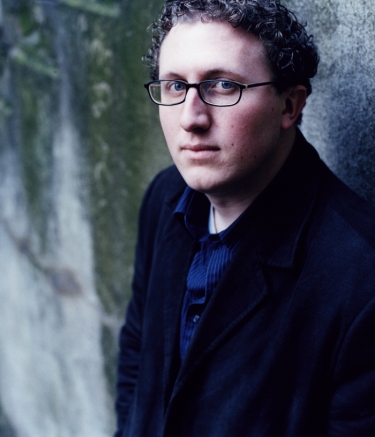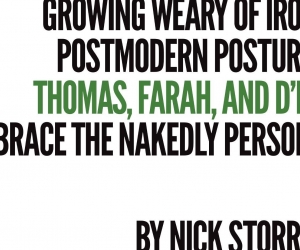In 2005, Christopher Mayo had a summer that unexpectedly changed his approach to composing. The Toronto-born composer spent three weeks at the Bang on a Can Summer Music Institute in North Adams, Massachusetts, where he came into contact with composers Michael Gordon, David Lang, Julia Wolfe, and Steve Reich. Mayo, who had recently gained a master’s degree at London’s Royal College of Music, received a generally positive response to his work from the composers he met in North Adams, but he says that he was surprised to find that “from an American perspective they felt my style was couched in modernist gestures, which they presumably considered to be a result of my European education. I certainly felt a closer affinity with Reich and the Bang on a Can composers than with those working in the European context, such as Pierre Boulez or Helmut Lachenmann, but at that point I was simply writing as I saw fit, without stylistic self-censorship.”
Finding himself placed uncomfortably on the wrong side of an apparent transatlantic divide, Mayo started to engage more critically with his own practice, while remaining in London to complete a Ph.D. at the Royal Academy of Music. He discovered that recoiling from modernist tendencies was not merely a statement of affiliation with American postminimalism, but a more fundamental reflection of his own creative temperament and aesthetic taste. “I don’t advocate populism,” Mayo now remarks, “but I think that spending ten-plus years of your life surrounded by other composers puts a certain unnatural shape on the landscape of new music.”
“The one undeniably skewed aspect of studying composition is that you are surrounded most of the time by people who are, in some way, interested in contemporary composition. On the one hand, that can be extremely helpful. On the other, it can lead to a cloistered approach. Composers whose audiences are almost exclusively other composers often end up writing music that only another composer could possibly like. Educational frameworks have given me numerous opportunities to execute my work, but the aesthetics fostered by the unnatural composer-centric lifestyle has given me something to react against.”
Recent works such as Binding the Quiet, a chamber piece commissioned in 2010 by Ensemble Contemporain de Montréal, and the winner of that ensemble’s Generation 2010 Audience Choice Award, are far removed from the hermetic tendencies of late modernism and its lingering academic advocates. For a start, the score is in C. “Talking with other composers, I’m often asked how I can be happy working with loaded tonal or post-tonal materials and metrical rhythmic structures,” Mayo observes. “I always ask back, how do they deal with the referentiality of their materials. Because for me, a violin scratch tone, circular bowing, mouthpiece pops on the tuba, or bass clarinet multiphonics, speak very clearly of a particular kind of western European sound world. Using them and pretending they are pure sonic material without cultural baggage is, I think, much more problematic than using a C-major chord with an awareness of what you are doing. Lack of recognition that new music has become so codified has resulted in a lot of dull music and lack of public interest. Some composers blame the audience for finding the sounds [the composers] use aggressive and difficult. It’s easy to forget that our starting point is already a very strange and alienating place to most audiences. I advocate music that is self-aware, that knows where it fits in the contemporary world.”
He is drawn to the inclusive approach that fellow composer Kyle Gann has termed Totalism, a music that potentially offers something for everyone and stimulates the body as well as the brain. Michael Gordon’s work possesses, in Mayo’s view, that kind of resourcefulness and appeal—an energetic rock-inflected surface and the formal clarity of patterned minimalism, but also underlying rhythmic complexity. Prior to co-founding the Bang on a Can festival and ensemble in 1987, Gordon not only studied composition at Yale with Martin Bresnick but also played in underground rock groups in New York. Listening now to the punchy rhythmic grooves in the central section of Mayo’s Knot (2008), a chamber piece written for Toronto’s Esprit Orchestra, you can hear something very close to the animating spirit of Gordon’s music.
But the persistence during the past few years of that strong allegiance to the Bang on a Can aesthetic hasn’t prevented Mayo recognizing his own connection with a far broader spectrum of compositional strategies and technical means. He is aware of the influence on his own practice exerted by Guillaume de Machaut, Olivier Messiaen, and Luciano Berio in their use of isorhythms; of Anton Webern, Conlon Nancarrow, and Louis Andriessen in their application of canonic techniques; of Frederic Rzewski, Philip Glass, and Georges Aperghis in their taste for number games; of the rhythmic experimentation of Henry Cowell, György Ligeti, and John Luther Adams; of Jean Sibelius in his manipulation of modes; of Charles Ives and contemporary Austrian composer Peter Ablinger in the space they allocate to found sound.
“In general, I use systems to generate my material,” Mayo explains. “It’s always a game—a way of coaxing yourself towards material and structures that you couldn’t possibly imagine through conventional means. There’s a lot of intuition in my approach to composing, but it’s always instigated by some sort of interaction with a systematic conceit. And there’s always something in there ticking away. I devise my own systems, though often they involve additive processes—which I guess I stole from Rzewski’s Les Moutons de Panurges. A lot of my processes are expansions and elaborations upon this kind of technique, to the nth degree; maybe having it operate on several levels at once: pitch material generated from a particular additive process, a quasi-harmonic layer cut into chunks and deployed in a similar way, and then much larger formal segmenting. The processes are my tools in creation and a huge part of the music, but they are not the surface in the way they were in early minimalism. Sometimes I think of it like sculpture. Using the system, I create a block that has certain properties; but then I can shape it into something else. And what if the materials don’t match the subject? What if your block of marble is more like a block of jelly? How does that affect what you can make out of it?
“I like working with arbitrary parameters. It’s fun. And I love the supreme musical awkwardness that sometimes arises: a rhythmic tic, or a bizarre harmonic or melodic movement. The process of composing then becomes a kind of normalisation of these oddities. In writing Clean Room Design: sous les mers (2010), I asked myself what would happen if I took an arbitrary piece of found material and imagined that it was the end point of my usual systematic approach. I took an audio clip, lasting about ten seconds, from a Spanish cartoon version of 20,000 Leagues Under the Sea and ran it through audio-analysis software to give me the data as pitches. I then reverse engineered a process and wrote a fifteen-minute piece, scored for performance by Montreal’s Nouvel Ensemble Moderne.
“I was inspired by the idea that whatever I might do with these materials, their own tendencies would be revealed and would gradually overwhelm my use of them. Clean Room Design: sous les mers attempts to overcome the fictional propensities of its own ‘genetic’ material. I decided that this material would have one very simple tendency related to its past life aboard Jules Verne’s submarine Nautilus—it wants to descend. Almost from the beginning this descent is inserted into the piece’s texture, making Clean Room Design: sous les mers a fictional struggle between the material and what a composer has tried to do with it. As such, this work is, for me, a narrative of the process of composition.”
Mayo’s implementation of systematic constraints may have resulted in a certain consistency of compositional approach, but the inspirational spark for individual pieces remains varied and unpredictable. His orchestral piece The Llano Curve (2007), for example, took shape after Mayo saw a series of moonlit images, the work of photographer Troy Paiva, depicting a gradual turn in the Pearblossom Highway, a stretch of California State Route 138. As program notes for the Royal Academy of Music Symphony Orchestra’s London première of the work made clear, the photographer’s techniques suggested parallel techniques used in Mayo’s music. “One of the most interesting aspects of long-exposure night photography is the behaviour of stars in a clear sky. If the exposures are long enough, the position of the stars will have changed while the shutter was open, drawing an arc of light through the photo. This expression of passing time in a static image was a key source of inspiration for this work, and the piece opens with an exploration of these ideas.”
Cartoon films, science fiction stories, nocturnal photography, poetry, spam e-mail, landscape, baseball, other music—Mayo’s source materials have been wide-ranging. Often, though, in the compositional process he will subject the same underlying material to radically different surface treatments. So the brash and gestural chamber ensemble piece Sturzstrom (2009), its title alluding to a kind of landslide, and the reserved, nearly static Very little perhaps nothing (2009) arise from the same “genetic” basis. If this testifies to Mayo’s fascination with transformations that occur in the process of working through a system, it’s also a sound practical strategy for a busy young composer working to a tight schedule.
Godfrey, another composition from 2009, actually alludes in its title to such procedures of creative recycling. “The work is named after Godfrey Ho, in acknowledgement of his astonishing aptitude for creating new works from pre-existing material,” Mayo explains. “Ho is a Hong Kong-based film director best known for his 1980s martial arts films. He would save money by generating several films out of the same basic footage, cutting and splicing shots together in a variety of configurations, interspersing footage from other films, and overdubbing new dialogue. Godfrey is a reworking and reinterpretation of harmonic and melodic fragments from my portion of 25 Brook Street, an oratorio written in collaboration with Charlie Piper, Mark Bowden, and Larry Goves to commemorate the 250th anniversary of the death of Handel.”
Piper and Bowden were members—along with Anna Meredith and Emily Hall—of The Camberwell Composers’ Collective, which Mayo joined in 2004. This grouping provided valuable mutual support among five young musicians, eager to write and perform their own music. Mayo suspects that he may well have jetted back to Toronto after completing his graduate studies at the Royal College if he hadn’t found himself in such sympathetic creative company. “The Collective gave me regular occasions to write new pieces and have them performed,” he recalls. “I was able to try risky, unexpected, possibly unsuccessful things. And just share ideas. I still send my scores to Anna or Charlie while I’m working on them, to get their input. And they do the same. There’s still a lot of feedback.”
Nonetheless, Mayo doesn’t feel that prolonged residency in London has conferred British identity upon his work. “I identify myself as a Canadian composer, shaped by being Canadian. People know what Dutch, French, British, or German music might sound like, and when they hear music by a person from that country some part of them is aware that this composer is either following or reacting against national tendencies. Canada’s classical scene is very young and doesn’t really have any historical style associated with it. I’ve actually had people here tell me that I’m the first Canadian composer they’ve heard of. If I mention Claude Vivier they either don’t know him, or think he was French. Being Canadian, I’m thankfully devoid of musical baggage that I feel I have to adhere to or overthrow.”
During 2009 Mayo took a step away from familiar working contexts and became involved in the realization of electronic musician Goldie’s—best known for his innovations in the jungle-and-drum-and-bass genre—project Sine Tempore, an orchestral commission for the BBC Proms. “My job was initially just to input Goldie’s ideas into Sibelius [a notation software], but as I was the only person in the room who’d ever written any notated music, it became a more collaborative process. I knew Goldie’s work and where he was coming from, but he didn’t want to do anything like that. In terms of a purely musical language, he was surprised that my iPod contained a lot of the same things that his did: we had a bonding moment over post-rock musician Sam Prekop fairly early on in the project. But in terms of telling me verbally what he wanted to do, Goldie . . . didn’t share a musical vocabulary [with me], so it was hard work. We spent weeks trying to write this piece. There was a lot of back and forth, a lot of long tea breaks. The end product was very much his music rather than mine. I don’t feel any creative ownership over the piece, but at the same time I know it would have been entirely different if I hadn’t been there. I could easily have just slipped into a mode of suggesting more and more things until it was mostly my composition, but Goldie didn’t want that, and luckily it didn’t happen. Any input of mine which shaped the piece was in aid of getting his ideas out, not putting my ideas in.”
Although Mayo has used vintage synthesizers to score a couple of short films, his first ensemble piece incorporating a really significant electronics component was performed in February 2011 by Motion Ensemble in Fredericton. Jolt Him, An Awl, A Sin uses sounds derived from a reading by poet Jonathan Williams, who died in 2008. “The reading was at City Lights Books in North Carolina, in May 2005,” Mayo explains. “The material I used is all of the sound except the actual reading. So there’s a lot of coughing, shuffling, clicking, and laughing. That forms a backing track. A percussionist also plays a MIDI pad that triggers a sampler, playing all the coughs. There’s not a tight sync between the ensemble and the backing, which is continuous ambient noise, but the first thing I did was to map out the laughing and coughing on a timeline, with a rough indication of how loud and how long. Then I worked with that as my form.”
The title Jolt Him, An Awl, A Sin pays tribute to Williams’ own linguistic playfulness and fondness for anagrams. The critic Hugh Kenner once described Williams as “the truffle-hound of American poetry,” on account of his unerring capacity for unearthing toothsome verbal nuggets from the soil of everyday life; words written on signposts, gleaned from letters or old books, inscribed on gravestones, or overheard in the street. Williams would often quote these verbatim, his own contribution being the form on the page and a heading that adds an artful gloss to the found words. “What I like about Williams’ poems,” Mayo enthuses, “is that they deal with found material so cleverly that they are forward-looking, even when using language that’s firmly rooted in the past. That’s something I’m aware of, too. I’m happy to use an old sound in a new way.”
In April 2011, Death on Three-Mile Creek, five poems by Williams set by Mayo for three sopranos and ensemble, premiered at a Young Artists Concert at New York’s Carnegie Hall. “I have a really hard time dealing with the contemporary music aesthetic of vocal writing,” Mayo confides. “Whether it’s really angular text-setting or extended technique, it just grates on me enormously. There are pieces written in that style that are fantastic: Ligeti’s Aventures, for example. But I find something very stilted in that approach, probably because I spend so much of my time enjoying non-classical vocal music. I have a tendency to set things melodically. I like to find ways to express the text without making the singer jump out of their skin.
“Recently, because I’ve been so busy, a style has developed in my work, if only through necessity,” he continues. “The last eight to ten of my pieces have been written in very similar ways, and I think this translates into an audible coherence. I don’t know if this is a direction, though. At the moment, with deadlines approaching fast and furious, I think it’s best to keep working in the way that I know works.” Mayo has that pragmatic, but also self-aware, sense of how his attractive and intelligent compositional voice is currently taking shape, factoring in consideration for musicians and audiences, and wary of hermetic trends in contemporary classical music.
In 2008 he wrote The Fitful Alternations of the Rain, setting a short poem by Percy Shelley for tenor voice and harp, which setting effectively evokes capricious weather. On the surface this song resembles mimetic Romanticism, the artist holding a mirror up to nature. But the harp’s rhythmic patterns actually result from Mayo’s characteristic use of an additive number sequence, comparable to that used with an entirely different outcome in, say, the chamber piece Sturzstrom. Deployment of systematic procedures has been creatively enabling for him. It also introduces a certain element of critical detachment vital to Mayo as he navigates the many options and possible routes open to a twenty-first-century composer.
He recognizes that certain forms of constraint can actually liberate the creative voice from assumptions and prejudices that might otherwise play a subliminally deterministic and detrimental role. Crucially, he points out, “The creation of rules and systems is not the creation of the music itself, but rather the creation of the language in which the music is spoken. There will always be a correlation between the language used and what it is used to say, but the language doesn’t define the story being told.”



